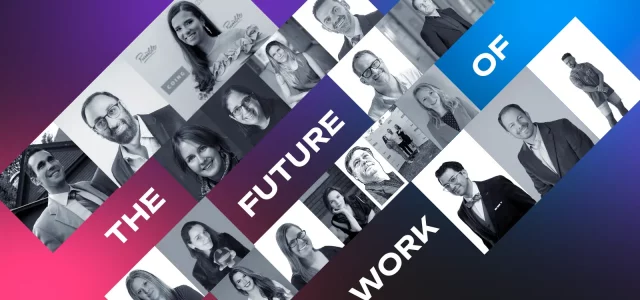Despite the ongoing wave of tech layoffs post-pandemic, IT talent still has no problem finding great job opportunities. According to CompTIA’s latest tech occupation report, in mid-2023, the tech unemployment rate has been the lowest since the start of the year — at just 1.8%.
So, if you thought the displaced talent would come begging at your feet for a job — think again. A Forbes analysis of the tech labor crunch shows that laid-off IT workers find new jobs within just a couple of months.
So, what can tech companies do to attract and retain top talent?
We talked to the representatives of 3 tech companies about the biggest challenges they face in terms of tech talent management — and how they address them:
- Biljana Rakic, VP of Human Capital at CAKE.com, the unicorn company behind popular work tools, Clockify, Pumble, and Plaky
- Fahad Sheikh, Head of Growth and Product at nTask, a project management tool
- Jüri Kaljundi, Co-Founder at Weekdone, an Objectives and Key Results (OKR) tool
The biggest challenges of tech talent management
The professionals we interviewed shared the biggest challenges they have faced in tech talent management — and explained why these challenges have been the biggest issues they have encountered:
- Lack of candidates and false promises of quick retraining,
- Finding the right candidate fit, and
- Employees leaving due to micromanagement.
Challenge #1: Lack of candidates and false promises of quick retraining
HR professionals in the tech industry are acutely aware of the huge skill gap in the tech job market. As the demand for skilled workers grows despite the layoffs, the candidate supply dwindles.
Unfortunately, this phenomenon has led to a rise in crash courses promising quick retraining for non-tech workers, which makes it even harder to find qualified candidates.
Biljana Rakic explains this in more detail:

“The educational system can’t produce as many candidates as are needed on the job market. That gap is compensated for through retraining programs, which are sometimes good — but often not so great.
The problem is that retraining programs are then used for propaganda purposes, to send a one-way message of fast learning and good pay — which is not the case in the market. So, it’s difficult to find the right people among all those candidates who have the potential to develop and put their knowledge into practice.”
Challenge #2: Finding the right candidate fit
To make talent sourcing even more difficult, it’s not enough to find a skilled candidate — they need to be able to adapt to your internal project management approach.
This seemingly simple technicality can represent a serious stumbling block for many candidates.
Fahad Sheikh elaborates on why this can be a problem:

“At nTask, we have to do some precise headhunting to get the perfect fit for us. We built our processes and workflows according to the Agile framework— and the biggest challenge we face is with candidates and new hires not being able to adapt to Agile, Scrum, and Kanban. We work on multiple forefronts led by our clientele’s expectations and MVPs that we share with them — hence, finding the right person who has hands-on knowledge and experience with these verticals becomes challenging.”
Further reading:
If you’re eager to learn more about how to implement Agile, Scrum, or Kanban into your workflow, check out these detailed guides:
Challenge #3: Employees leaving due to micromanagement
Gone are the days of managers hovering over their employees, controlling their work every step of the way, and spoon-feeding them information.
Today, workers, especially those in tech, want to know how their work fits into the bigger picture — and they want to have more autonomy.
Jüri Kaljundi explains why it’s important to give them that:

“We know that a huge challenge is that employees don’t know what’s expected of them and why. There are different teams or individuals running in different directions — not towards unified goals. There needs to be a clear value proposition towards employees nowadays. Employees’ interests are just as important as company interests and should always be kept in mind.”
8 tips for developing a successful tech talent strategy
Finding and retaining top talent is becoming increasingly difficult. But seasoned professionals make sure they stay ahead of the game by finding what works best for them through trial and error.
With the above challenges in mind, we asked our interlocutors about the tried and true ingredients of their internal tech talent strategies.
We bring you their top tips for developing a tech talent strategy that works.
Tip #1: Invest effort into keeping the acquired talent
Acquiring tech talent is hard — but keeping it is close to an Olympic sport.
Unsurprisingly, according to a LinkedIn study, the tech industry has the highest turnover rate — 13.2%.
If your talent strategy ends at acquisition, you’re bound to join the grim statistics.
It’s essential to keep tending to your people continually if you want them to stay with you. If you don’t make sure to always listen in on their needs, nothing will stop them from accepting one of the great job offers they probably get on a regular basis.
Fahad Sheikh understands the importance of a strong and continuous approach to nurturing internal talent:

“We work with a strong inbound talent strategy, and our onboarding process is designed to prepare our new hires to adapt to the challenges of our organization. The same practice is continuously done with our veterans, and we follow a few principles that allow us to achieve maximum productivity and employee happiness.”
Tip #2: Ensure employees understand and share in the company goals
Jüri Kaljundi reveals that communicating company-wide goals is an important element of Weekdone’s talent management approach:

“It all starts from having a clearly defined mission and goals, on all levels, and for different time periods, be it a year, quarter, or week. You then need to communicate this clearly to everyone — and be open to feedback along the way.
Communication is never one-way! You need to listen to your employees and team managers when coming up with plans and objectives or deciding on how you measure their progress towards success. OKRs [Objectives and Key Results]are a great way to achieve that.”
However, it’s not enough to simply set goals and hope for the best. Jüri continues:

“Once goals are set, you need to continue having the discussions — to make sure employees both understand them, as well as believe in them. This will keep people motivated and engaged. Weekly team meetings and one-on-ones are both good places to have these regular check-ins.”
Tip #3: Create tailor-made mentorship programs
Tech companies usually do provide mentorship programs to new hires — but the key is to customize them for each individual employee. Biljana Rakic explains how mentorship works at CAKE.com:

“At CAKE.com, we make mentorship programs that last at least a month. They follow a base format — there are certain elements they all have in common, i.e., our programs have 6 strategic points all employees have to go through. But, besides those 6 points, all mentorship programs are customized, based on the previous knowledge of the employee.”
Developers go through these programs, no matter their seniority:

“Each person gets a mentor — which is usually the team lead, but it doesn’t have to be. It can also be a coworker from the team. If all team members are seniors, they can’t mentor each other per se, but they can practice a kind of intervision — a sort of peer mentorship.”
Tip #4: Help with social integration
Mentorship programs help employees adapt to how the company operates, but Biljana believes social integration plays another important role in tech talent management. In her experience, successful social integration helps employees:
- Think quicker and smarter,
- Do things faster and be more satisfied with the outcomes,
- Be at a lower risk of burnout, and
- Be at a lower risk of turnover.
That’s why CAKE.com implements a work buddy system:

“For a work buddy, we look for someone within the company who can understand the job of the new hire, but works on a different project — because the focus of the work buddy system should be on social integration and not work.”
Biljana also believes it’s good practice to match people who “speak the same language” and have similar interests and approaches to work:

“For example, an Android developer at Clockify can be a work buddy to an iOS developer at Pumble.”
Tip #5: Offer flexibility
In the post-pandemic world — where most tech companies have moved to remote or hybrid work models — offering workers flexibility in terms of location and hours should be a no-brainer.
A Gartner research on work flexibility has found that, when employees are provided with choices as to where, when, and how they work, the percentage of high-performers surges by 40%.
According to Jüri Kaljundi, by offering flexibility, you gain a serious competitive advantage:

“Great people are spread across all continents, so stay competitive by offering asynchronous communication channels and flexible working times to support work-life balance for your talent.”
Tip #6: Cultivate a company culture
The talk of company culture often stays at the surface level. Companies claim they have one — when, in reality, they have a mission and a vision statement on their website, and that’s where it ends.
For Fahad Sheikh, practicing what you preach in terms of company culture is an important element of a successful inbound talent strategy:

“Culture and ideas develop from the ground up and should always be cultivated, not curated.”
Biljana Rakic agrees, and believes that, when core values align, employees are much more motivated to do their job:

“We have a competency-based interview and a value-based interview. We’re more focused on the latter because we want the people we hire to share in our value system. And, even if a person isn’t that great of a talent, if they’re motivated, they’ll achieve more than someone who’s maybe naturally a faster learner — but lacks motivation.”
Tip #7: Look for proactive candidates
HR professionals often put emphasis on the knowledge and experience of prospective candidates. However, Biljana Rakic shares another candidate trait CAKE.com is always on the lookout for:

“What we look for, aside from some human values important to us — such as respect for diversity, love, and similar — are candidates who are proactive. Being proactive means that, when they get the assignment, they first try to solve it themselves, no matter how difficult it is, in a way that’s not expected.”
To Biljana, that proactive streak is a positive sign that the candidate will enjoy their job and make progress more easily:

“We’re looking for that proactiveness, an explorative mind, and intrinsic motivation to solve the problem, to commit to it. So when they get home, they can think about work in a non-burdensome way, in the context of ‘What a fun problem — let’s see if anyone has already solved it.’ So they don’t see it as work, but rather as a fun way of exploring.”
Tip #8: Eliminate micromanagement
Micromanaging your tech talent is a surefire way to drive them away. However, striking the right balance between micromanagement and undermanagement can be tricky.
According to Fahad Sheikh, at nTask, they solve this problem by utilizing one of the tips we’ve already mentioned:

“Eliminate micromanagement by actively keeping people aligned with the macro view and goals of the organization. There’s no need to keep deep checks on things when the team truly understands where we are headed.”
At CAKE.com, a huge emphasis is placed on avoiding micromanagement. However, Biljana explains that this can be tricky when working with juniors who require constant supervision, which can easily slip into micromanagement. Here’s how they solve that problem through mentorship:

“Working with juniors is oddly specific, and we usually pair them up with people who are highly systematic — i.e., those who can start explaining from scratch, who remember the most basic things in their field, and who talk less on a meta-level and more in practical terms. That’s why we often give junior developers to mentors who were themselves juniors when they started here.”
Conclusion: Your tech talent strategy should be an ongoing effort
There’s no doubt that tech companies struggle to attract and maintain top talent. But by optimizing their talent strategies, they can improve their odds in the tech job market.
If you’re struggling to find and keep tech talent, give these tips a try — if they work for the industry professionals we interviewed, they might just work for you too.
Alternatively, mix and match what works best for you and fine-tune your strategy through trial and error to achieve the best results over time.
Further reading:
For more tech world insights from Biljana Rakic, you might want to check out our interview with her on the advantages and disadvantages of a remote-first work model:




